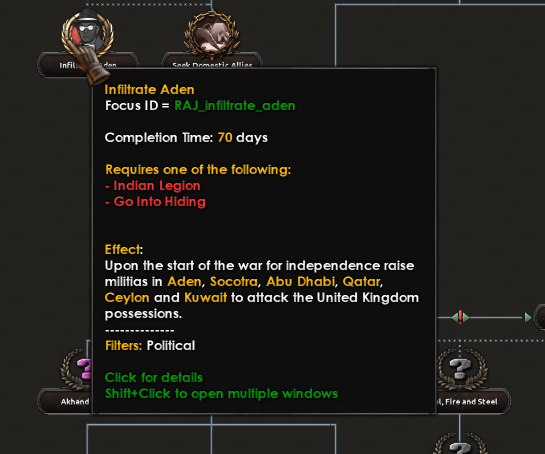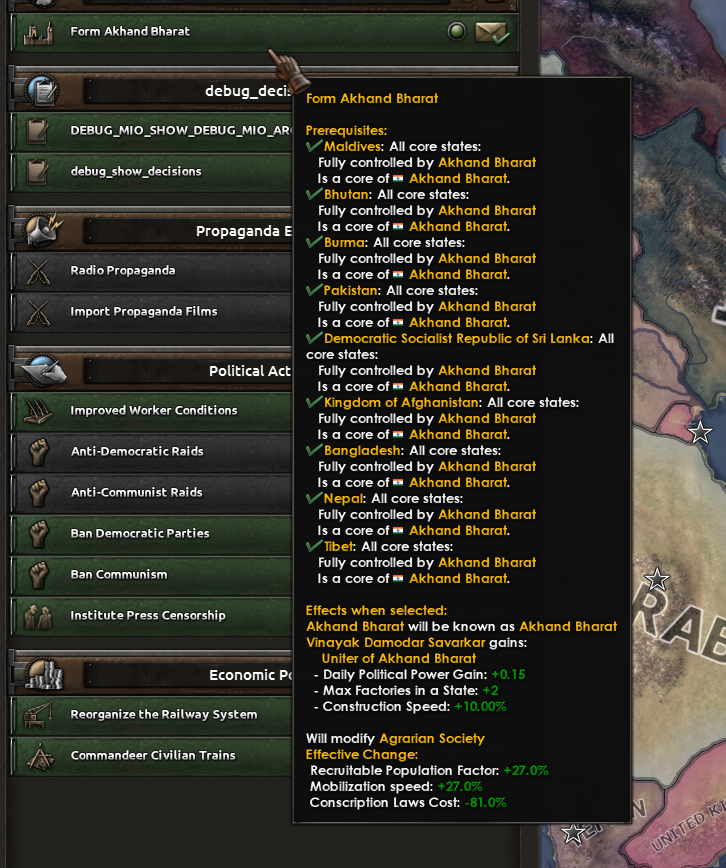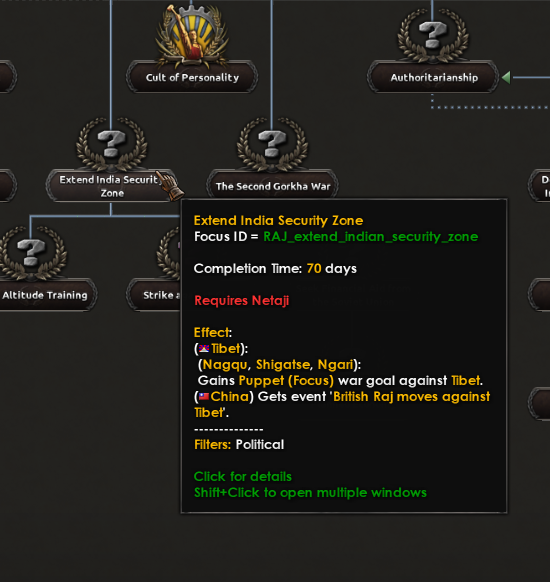Toot


And welcome.
This week we will take a look at the alt-history paths for the RAJ. So without further ado.
Forward Bloc
If you go down the League Against Gandhist, and proceed down the Forward Bloc plan you will end up with Subhas Chandra Bose as its leader. This is a more militant stance towards the British, with the end goal of leading a war of independence.The War against the British will start when you complete Give Me Blood And I Will Give You Freedom, and which states join you in the civil war will be determined by how big the resistance is.

The idea is that you are using the resistance system to agitate the local population against British rule, flipping the resistance system on its head. The higher resistance is at the start of the civil war, the more people will join you.
This can be increased in two ways: you can promote resistance in a certain state.

But you can also undo your own cores to further boost resistance.

These will be re-cored once the independence war starts
If you know your history, this will trigger the British government to try and arrest Bose. You can make him leave India for a time, and he will begin his famous journey avoiding arrest.

Should you for some reason not let him go on the run, he will start the civil war imprisoned, and you can free him by controlling the British aligned India's capital. In this case he ended up in Karachi

When you go to the war for independence the UK will enter against you as well, but with some tricks you can make it simpler. For example you can infiltrate the closest English possessions and try to take control.

You can also do what Bose did historically, and ally with the Japanese. They will then try and help you out, joining your side when the time is right.

This picture below is what an actual war might look like

I have also gained control of a lot of close ports, which I plan to use for my Japanese naval bombers gained from a previous focus to take potshots at convoys.

When you successfully capitulate UK-aligned Raj you get the option of white-peacing out, so that you don't need to be stuck in an endless war.

After having kicked out the English you are now free to decide between keeping Bose, or changing leaders to Vinayak Savarkar.

Hindutva
How it works is that you target a country and instantly gain cores on all those required states. You will not be able to continue claiming more countries until you control every state that you previously claimed.

For example when I claim Burma I get cores on them instantly, but I cannot continue on my quest until I control all Burmese states.
To help with this, Sarvakar has attack bonus on cores that he claims, can justify quicker, but most importantly you are able to build up your Hindu militarism as a spirit via focuses.

Once all is said and done you can finally form Akhand Bharat

This gives him a nice trait, but also reduces Agrarian society by about 1/3 instantly.

Netaji

Here you seek to extend India's security zones, eventually (probably) coming into conflict with China.

Ever the pragmatist, you can also seek aid from the USSR, and model some of your economy on theirs.

You also get to decide how to rule your country, either under a more militaristic authoritarian style, or under a guided democracy, where you still retain control over the country, but there is a semblance of elections. At the end your goal is to liberate the subjects from British rule.

Reds in the Shadow

On this path you are stacking your cabinet with communists, trying to get enough support for communism, and kicking off a Royal Navy Mutany (inspiration) which eventually escalates into you taking control over India.

This doesn't result in a direct confrontation with the UK, but it does lead to religious people leaving India, creating a more powerful Pakistan as they consider it to be more stable. Britain will also start funneling economic aid to Pakistan, trying to counter increasing Communist influence in the area. Pakistan on this path serves as a tertiary antagonist whom you eventually want to take out.

At first you enter a truce with Pakistan, but you can eventually annex it, coring the subcontinent at once.

If successful, Pakistan might have acquired more industry from the British, indirectly strengthening you.
You can also mold your 5 year plan, in a similar way to the USSR, or lean more towards an Indian form of socialism.

The East India Company
Taking a step back, at the start of the game the Raj now starts with the Great Depression, similar to other TfV trees like Australia and Canada. This is removed quite early on in the Industrial tree going down the Independence path, but you also have a mutually exclusive choice to make, to deal with the depression immediately.

This means tying the price of the rupee to the sterling, which drastically reduces the negative effects of the depression, causing the Raj to turn volatile due to monetary chaos.

Here, you can look to the future. Realizing that the price controls eventually will fail, you can lobby the British parliament to sell off parts of India to private investors, to reduce government spending on trying to stabilize the continent.

You are no longer playing as a country, but as a company.

This comes with some unique gameplay mechanics. How do you like them taxes?!

You are beholden to the tax office since you are, well, a corporation. As such you need to pay income tax. At the end of every fiscal year (starting when you complete the EIC focus), you get slotted into a tax bracket (
For example I have one civilian factory, which means that I get slotted into the first tax bracket, and I get to pay 0% taxes. Should I go up to 9 civilian factories, I will need to pay 15% taxes during the next fiscal year. (this is as consumer goods).
As you might see, having more civilian factories might be a detriment. For example, if the end of the fiscal year is coming around, and I have 30 civilian factories, It might be better for me to remove 1 factory and get slotted with 30% consumer goods, than 60%. There are different ways of using these civilian factories, so pay close attention, because we are going to commit tax fraud. (by the way, only controlled civilian factories in states count for this, so not traded, offsite civilian, factories from subjects, mils or dockyards)

So how can we, basically commit tax fraud? Well first off, every fiscal year you can pay dividends to investors if you want to. This will remove certain civilian factories for a boost for the entire year. So you are basically paying investors dividends, which means they invest more for the next year.

You can also use civilian factories to outright buy land. This is cheaper for the Indian subcontinent than say, a state in the USSR. It is also how you eventually will gain control over the states you "lost" at the start of the game diplomatically.

When you gain enough control you also get focuses to boost puppets, meaning they give you way more industry.

Later on in the tree you can shuffle your factories into your puppets as well, meaning you can funnel away some of your factories.

And then buy back the land for yourself if you'd like.

Later on in the tree you will also be able to reduce the amount of taxes paid by expanding tax loopholes.

And also increase the tax brackets, meaning you can stay in the same (low) tax bracket for longer

When you buy enough of the RAJ, you can annex the rest, effectively seizing control over the subcontinent, with the end goal of finally becoming fully independent from London.
Here you can either crush your Anathema, the Communists, or go after your old overlords, the British. You can also now core owned states with a massive influx of civilian industries, locked behind compliance. This is cheaper in Indian core states, which is how you eventually regain all your cores.

To the left of the tree you can form your own private military, where your volunteers get civilian factories for fighting in foreign wars.

To protect your interests and trade routes, you can also focus on building a flagship by gathering different prerequisites


The Mughal Empire
You achieve this by stirring discontent in the Northern parts of Pakistan.

You then break away, far from Delhi where authorities can't really get to you. Subsequently you get to choose a Peacock prince for your new empire, with any of the princes included in the DLC.


This is also the path where you get the new unique unit, the elephantry, an evolution of the camelry and cavalry.

This path is much more conquest focused, with choices between expanding into the Indian sub-continent or north into Afghanistan, the Wakhan corridor and onwards to Mongolia

You can also gain help from the princes to reclaim the continent from the British

When you declare war against the Loyalist Raj they will rise up with you, as your puppets.

They will then join your court as advisors

One optional thing in this path is rebuilding a new Silk Road by connecting your country to the road that ran from Asia to Europe. This is a tiered formable that goes up to Sinkiang from Afghanistan, into China through the Warlords, and then into Europe from either Iran-Turkey or through the USSR, or the Sea route into Venice.

When you complete all the tiered formable decisions, you become the Silk Road Empire

I will leave it here, but finally I'd like to especially once again give a shoutout to Aveebee and pdx_lily who have helped immensely. I'd also like to give a shoutout to the art team juggling my art requests, and to the QA team, especially IterumLuna for managing everything.
Thank you all and see you in the graveyard!
Toot





.jpeg)
